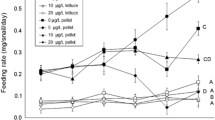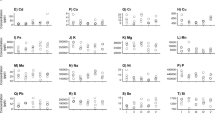Abstract
Oral intake of cadmium can disrupt calcium metabolism in laboratory rodents. If this occurs in free-living wild rodents, reproductive potential, growth, and survival could be adversely affected. This study investigated whether an environmentally-realistic intake of cadmium (1.5–1.7 mg/kg BW/24h) by bank voles, Clethrionomys glareolus, affected uptake and assimilation of calcium and also that of magnesium and phosphorus, two elements metabolized in close association with calcium. Mineral metabolism was monitored in bank voles fed four different diets; two diets were relatively low (0.12%) in calcium and contained either no cadmium (LC) or cadmium (LCCd), while the remainder were relatively high (0.74%) in calcium and also contained either no cadmium (HC) or cadmium (HCCd). Dietary calcium levels were varied because calcium can affect gut absorption of cadmium, and calcium levels in natural forage vary with habitat soil type.
Cadmium had a significant effect on voles fed a low calcium diet. Animals given LCCd diet had significantly poorer calcium net gut absorption efficiency than animals fed the corresponding control (LC) diet and were in negative calcium balance, losing approximately 0.5–1% of body calcium reserves each day. In contrast, calcium inputs matched total outputs in animals fed the LC diet. Cadmium had no effect on net gut absorption of magnesium and phosphorus, but renal reabsorption and subsequent assimilation of these elements was greater in animals fed the LCCd diet than in those given the LC diet.
Cadmium had no clear effect on macroelement metabolism in bank voles fed a diet relatively high in calcium. Net gut absorption and assimilation of calcium by voles fed the HCCd diet was reduced to the same extent as observed in animals fed the LCCd diet. However, because of their high dietary calcium intake, voles fed the HCCd diet maintained a positive calcium balance and there was no significant difference in calcium assimilation between animals fed the HCCd and HC diet. Cadmium had no effect on magnesium and phosphorus metabolism in voles fed high calcium diets.
Similar content being viewed by others
References
Allen SE, Grimshaw HM, Parkinson JA, Quarmby C (1974) Chemical analysis of ecological materials. Blackwell Scientific Publications, London, 565 pp
Ando M, Sayato Y, Tonomura M, Osawa T (1977) Studies on the excretion and uptake of calcium by rats after continuous oral administration of cadmium. Toxicol Appl Pharmacol 39:321–327
Ando M, Shimizu M, Sayato Y, Tanimura A, Tobe M (1981) The inhibition of vitamin D-stimulated intestinal calcium transport in rats after continuous oral administration of cadmium. Toxicol Appl Pharmacol 41:297–301
Barkley SA, Batzli GO, Collier D (1980) Nutritional ecology of microtine rodents: A simulation model of mineral nutrition for brown lemmings. Oikos 34:103–114
Batzli GO, Pitelka FA (1983) Nutritional ecology of microtine rodents: Food habits of lemmings near Barrow, Alaska. J Mamm 64:648–655
Bindels RJM (1993) Calcium handling by the mammalian kidney. J Exp Biol 184:89–104
Bonner FW, King LJ, Parke DV (1981) The acute and sub-acute effects of cadmium on calcium homeostasis and bone trace metals in the rat. J Inorg Chem 14:107–114
Bremner I (1979) Mammalian absorption, transport and excretion of cadmium. In: Webb M (ed) The Chemistry, biochemistry and biology of cadmium. Elsevier, Amsterdam, pp 175–193
Briese LA (1973) Variations in elemental composition and cycling in the cotton rat Sigmodon hispidus. MSc, University of Georgia, Athens, GA, 76 pp
Gmaj P, Murer H (1984) Intestinal and renal absorption of calcium. In: Sigel H (ed) Metal ions in biological systems: Calcium and its role in biology. Marcel Dekker Inc, NY, pp 99–127
Hansson L (1991) Bark consumption by voles in relation to mineral contents. J Chem Ecol 17:735–743
Hansson L (1992) Vole densities and consumption of bark in relation to soil type and bark mineral content. Scand J For Res 7:229–235
Hunter BA, Johnson MS, Thompson DJ (1987a) Ecotoxicology of copper and cadmium in a contaminated grassland ecosystem. I. Soil and vegetation contamination. J Appl Ecol 24:573–586
Hunter BA (1987b) Ecotoxicology of copper and cadmium in a contaminated grassland ecosystem. II. Invertebrates. J Appl Ecol 24:587–599
Hunter BA (1987c) Ecotoxicology of copper and cadmium in a contaminated grassland ecosystem. III. Small mammals. J Appl Ecol 24:601–614
Jensen A, Jorgensen SE (1984) Analytical chemistry applied to metal ions in the environment. In: Sigel H (ed) Metal ions in biological systems, Vol. 18, Circulation of metals in the environment. Marcel Dekker Inc., NY, pp 287–332
Kaufman DW, O'Farrell JO, Kaufman GA, Fuller SE (1976) Digestibility and elemental assimilation in cotton rats (Sigmodon hispidus). Acta Theriol 21:147–156
Kobayashi J (1974) Effects of cadmium on calcium metabolism of rats. In: Hemphill DD (ed) Trace substances in environmental health-VII. University of Missouri Press, Columbia, MO, pp 295–305
Robertson WG (1976) Urinary excretion. In: Nordin BEC (ed) Calcium, phosphate and magnesium metabolism, clinical physiology and diagnostic procedure. Churchill Livingstone, London, UK, pp 113–161
Sawicka-Kapusta K, Zakrzewska M (1994) Effect of cadmium and lead on postnatal development and mortality of rodents. Pol Ecol Stud 20:43–50
Schultz AM (1964) The nutrient-recovery hypothesis for Arctic microtine cycles. II. Ecosystem variables in relation to Arctic microtine cycle. In: Crisp DJ (ed) Grazing in terrestrial and marine environments. Blackwell Scientific Publications, Oxford, UK, pp 57–68
Schultz AM (1969) A study of an ecosystem: The Arctic Tundra. In: Van Dyne GM (ed) The ecosystem concept in natural resource management. Academic Press, NY, pp 77–93
Shore RF, Myhill DG, Polwarth G, Dunmow M (1991a) The effects of chronic doses of dietary cadmium on macro-element balance in wood mice, Apodemus sylvaticus and bank voles, Clethrionomys glareolus. In: Momcilovic B (ed) Trace elements in man and animals 7. Institute for Medical Research and Occupational Health, Zagreb, Yugoslavia, pp 26–17–26–18
Shore RF, Balment RJ, Yalden DW (1991b) The effect of habitat geology on calcium intake and calcium status of wild rodents. Oecologia (Berlin) 88:539–546
Shore RF, Douben PET (1994) The ecotoxicological significance of cadmium intake and residues in terrestrial small mammals. Ecotoxicol Environ Saf 29:101–112
Shore RF, Yalden DW, Balment RJ, Sparks TH (1992) The effect of variation in calcium intake on the growth of wood mice and bank voles. Oecologia (Berlin) 92:130–137
Sugawara N (1977) Inhibitory effect of cadmium on calcium absorption from the rat duodenum. Arch Environ Contam Toxicol 5:167–175
Talmage S, Walton BT (1991) Small mammals as monitors of environmental contaminants. Rev Environ Contam Toxicol 119:47–145
Wang C, Bhattacharyya MH (1993) Effect of cadmium on bone calcium and 45Ca in nonpregnant mice on a calcium-deficient diet: Evidence of direct effect of cadmium on bone. Toxicol Appl Pharmacol 120:228–239
Wang C, Brown S, Bhattacharyya MH (1994) Effect of cadmium on bone calcium and 45Ca in mouse dams on a calcium-deficient diet: Evidence of Itai-Itai-like syndrome. Toxicol Appl Pharmacol 127:320–330
West SD (1982) Dynamics of colonization and abundance in central Alaskan populations of the northern red-backed vole Clethrionomys rutilus. J Mamm 63:128–143
WHO (1992) Environmental Health Criteria 134: Cadmium. WHO, Geneva, 280 pp
Wilkinson R (1976) Absorption of calcium, phosphorus and magnesium. In: Nordin BEC (ed) Calcium, phosphate and magnesium metabolism, clinical physiology and diagnostic procedure. Churchill Livingstone, London, pp 36–112
Wlostowski T, Chetnicki W, Gierlachowska-Baldyga W, Chycak B (1988) Zinc, iron, copper, manganese, calcium and magnesium supply status in free-living bank voles. Acta Theriol 41:555–573
Zakrzewska M, Sawicka-Kapusta K, Perdenia A, Wosik A (1993) Heavy metals in bank voles from Polish national parks. Sci. Total Environ. Suppl. 1993, Part 1:167–172
Author information
Authors and Affiliations
Rights and permissions
About this article
Cite this article
Shore, R.F., Myhill, D.G., Routledge, E.J. et al. Impact of an environmentally-realistic intake of cadmium on calcium, magnesium, and phosphate metabolism in bank voles, Clethrionomys glareolus . Arch. Environ. Contam. Toxicol. 29, 180–186 (1995). https://doi.org/10.1007/BF00212968
Received:
Revised:
Issue Date:
DOI: https://doi.org/10.1007/BF00212968




